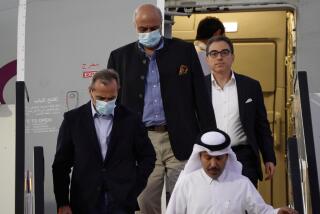Access delay may give Iran time to obscure data
- Share via
GENEVA — Iran’s promise to admit inspectors to a secret nuclear plant, though hailed as a major step this week by U.S. officials and their allies, may come too late to glean key information about the facility’s design and history, experts and foreign government officials said Friday.
Allowing access within two weeks of the announcement would in effect give Tehran almost a month after its Sept. 21 acknowledgment of the plant’s existence to obscure evidence, they said.
David Albright, a former international weapons inspector and president of the Washington-based Institute for Science and International Security, said it would probably take Iran some time to conceal activities. But, “if you have a month, you have the time,” he said.
A European official who declined to be identified because of the sensitivity of the issue said the six world powers “did well” to win Iran’s agreement to permit access. But the official acknowledged that swifter access would have been better.
U.S. officials contend that inspectors will be able to gather essential information if they are admitted within two weeks.
But Albright said faster is better. “It’s not good that the inspection has taken so long,” he said.
“There is no reason it could not have happened yesterday,” he said. “It should have.”
Iranian officials pledged Thursday during high-level international talks near Geneva to allow United Nations nuclear inspectors access to the plant “within the next couple of weeks,” European Union foreign policy chief Javier Solana said.
The United Nations’ nuclear watchdog, the International Atomic Energy Agency, has stated that inspectors need access to facilities as soon as possible.
Mohamed ElBaradei, the IAEA’s director-general, complained bitterly when inspectors were unable to scrutinize a suspected Syrian nuclear plant until eight months after it was destroyed in a September 2007 bombing raid by Israel.
Iran has previously gone to great lengths to conceal nuclear activities.
Charles D. Ferguson, a nonproliferation expert and former State Department official now with the Council on Foreign Relations, recalled that when the so-called Lavizan site on the outskirts of Tehran came under suspicion as an undeclared nuclear site in 2003, Iran delayed access. Ultimately, the Iranians razed the building and covered it with topsoil, satellite photos have shown.
In the case of the new plant near the holy city of Qom, Iranian officials contend that they did not violate their treaty agreement because the facility was more than a year from completion, and rules did not require them yet to notify the IAEA.
Western officials contend that under agreements in force, Iran was required to notify international authorities.
It is still uncertain when the IAEA inspectors will be able to tour the plant. U.S. and European officials said ElBaradei was planning to go to Tehran this weekend. But IAEA officials said only that he intends to visit the Iranian capital soon.
An Israeli official said it remains uncertain whether inspectors will be permitted to visit the plant. “We don’t know whether they will be let in. There are so many unknowns at this point,” he said.
Israel views Iran’s nuclear activities as a mortal threat, but an official said the government is willing to let developments take their course.
The deal to give IAEA access was included in a three-part agreement worked out with Tehran by the U.S., Germany, Britain, France, China and Russia. Under the terms, Iran has agreed to discuss a full range of nuclear issues with the six nations and to convert most of its stockpile of low-enriched uranium to medical isotopes, making the material unavailable for any bomb-making.
--
Times staff writer Richard Boudreaux in Jerusalem contributed to this report.
More to Read
Sign up for Essential California
The most important California stories and recommendations in your inbox every morning.
You may occasionally receive promotional content from the Los Angeles Times.











